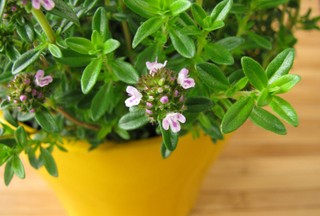The complete guide to growing savory indoors

Savory is typically used as a descriptor for food that is spicy or salty rather than sweet, but it’s also a type of herb that can be grown to impart those same flavors into your food. Like many other herb plants, the common types of savory make excellent container plants in an indoor herb garden.
Types of Savory
There are over thirty different types of savory that can be grown, with winter and summer savory being the two most common here in the United States. Both are members of the Lamiaceae, or mint family. Although they are similar in appearance and flavor they have some big differences in how they are grown.

Winter
Winter savory, Satureja montana, is a spreading perennial herb that grows 6 to 12 inches high with narrow, dark-green leaves. It has a stronger, earthier flavor than summer savory, with notes of sage and pine.
Also known as mountain savory this herb makes an attractive border plant in any herb or vegetable garden and flourishes when grown indoors in containers. Small clusters of flowers bloom in the mid to late-summer ranging in color from pale lavender, to pink, or white depending on the cultivar.
Summer
Unlike winter savory, summer savory is grown as an annual herb. Satureja hortensis is another low-growing plant and is related to rosemary and thyme. It presents a hot, peppery flavor with notes of marjoram, mint, and thyme.
Summer savory grows to a height of 12 to 18 inches and features thickly branched stems covered in narrow dark green leaves. Mid-summer, it produces small white, pink, or lilac flowers with seeds forming shortly after it blooms.
Seasonal differences
As mentioned, the biggest difference in the two types of savory is winter savory is grown as a perennial and summer savory only as an annual.
- Perennial plants regrow year after year, often going dormant in the colder winter months and then the top part of the plant begins regrowing as the weather warms in the spring. Blooming and setting seeds is not a life-ending process and they can repeat the process for many years if given the right growing conditions.
- Annual plants complete their entire life cycle from seed to flower to seed again in a single growing season. They do not grow again the following year.
Winter savory can tolerate both high summer temperatures and winter cold down to 10℉. It can be grown in USDA hardiness zones 5 through 11.
Summer savory, on the other hand, tolerates heat but not cold, hence the need to grow it as annual in hardiness zones 1 through 11.


The enthusiast's guide to herbs
We’re proud to present our new e-book, The Enthusiast’s Guide to Herbs! Learn everything you need to know about growing and caring for herbs indoors, including in-depth info cards for the 35 most commonly grown herbs.
Click the link below to find out more!
How to plant Savory
One of the advantages of growing savory indoors in containers is that you can have plants growing year-round regardless of the outside temperatures. When grown in an outdoor herb garden summer savory will die as the temperatures drop in the fall.
Both types grow very well from seed, so it’s recommended to sow seeds versus taking plant cuttings to propagate new plants. Winter savory has woody stems as it matures which offers the ability to take and root stem cuttings although it isn’t the preferred method.
Planting Savory seeds
Savory seeds can be sown any time of year when growing plants indoors but it’s best to start them in the spring. As your seedlings grow their rapid growth will correspond with increasing day lengths and more sun exposure.
Supplies
Containers: Choose from either clay (either glazed or unglazed) or plastic pots based upon your personal preference and style. If growing a single plant a 6-inch pot is sufficient; 3 plants can be grown together in a 12-inch container.
Growing Media: Commercial potting mixes and coconut coir both make excellent substrates for growing plants in containers. Contrary to their name, potting soils contain no soil but are a mix of peat moss or coconut coir, pine bark, perlite, and vermiculite. Coconut coir is a renewable material made from the brown and white fibers found between the shell and the outer coating of a coconut seed. Both media are lightweight with excellent moisture retention.
Seeds: Savory seeds may not be commonplace at your local nursery or garden center. You can purchase them online through numerous seed retailers, or collect seeds from a friend who is growing savory for themselves.
Supplemental lighting: Plants need a high amount of sunlight when grown indoors, to see maximum growth and yield. Often times indoor spaces cannot provide the full-sun conditions similar to growing outside; in this case, plants should be supplemented with light via grow lights. Simple setups can be purchased online or a local gardening center.
Steps
Starting savory from seeds follows basic planting methods for other herbs:
- Fill the container(s) with the pre-moistened growing media of your choice.
- Sprinkle a small number of seeds across the top of the substrate. There is no need to cover them, the light helps germination.
- Place container(s) in an area where the ambient temperature is at least 70℉. You do not need to provide bottom heat for germination.
- Keep the soil moist but not saturated. Water helps to break down the seed coat, activating the processes that occur during germination while softening the exterior to allow roots and shoots to emerge.
- Thin plants when they reach a couple of inches tall. Keep the single, best-looking plant for a 6-inch container. Keep the three best-looking seedlings for a 12-inch container spacing them as far apart as possible.
Propagation via cuttings
Stem cuttings have a much lower cost than purchasing seeds, but the challenge lies in finding a plant to take cuttings from. Savory plants aren’t as common as herbs like basil, rosemary, thyme, etc.
Supplies
The supplies needed for propagation via cuttings are similar to sowing seeds. You’ll need containers, growing media, supplemental lights (optional), and a healthy plant to take cuttings from.
Steps
To start plants from stem cuttings follow these directions:
- Take a 4-inch stem cutting right below a node and remove all of the leaves from the bottom 2 inches of the stem.
- Place the cut end of the stem in a glass or jar of water, allowing it to grow until newly generated roots are a couple of inches long.
- Fill the container(s) with pre-moistened growing media of your choice.
- Carefully plant newly rooted cuttings in the substrate, 1 cutting per 6-inch pot and 3 per 12-inch container.

Caring for your savory plant
Savory requires regular, even watering until the plants are established. Once savory is established the growing media can be kept on the slightly dry side.
Set your containers in a spot where plants will receive full sunlight a minimum of 8 to 10 hours a day. If plants become leggy, move them to a spot where they can get more sun exposure and pinch back the main stems to encourage the plant to get bushier.
There is no need to fertilize your winter or summer savory; it will grow successfully with no additional nutrients, but you can give it a weak dose of an all-purpose fertilizer mid growing season.
Harvesting
Once your plants reach 6-inches in height, you can begin harvesting material off of them.
If you are harvesting leaves for fresh use, you can remove both the leaves and stems using sharp, disinfected scissors at any time of year. After removing from the sprig from the plant strip the leaves off for use.
If you are harvesting your savory for drying, harvest leaves just before the flower buds open to have material with the strongest flavor. When the flowers bloom it decreases the content and quality of essential oils in the leaves.
Using your savory
Savory is used primarily in recipes but also has numerous medicinal purposes.
Culinary
The most common use for both winter and summer savory is as a flavoring in dishes or recipes. Use the milder flavored summer savory in the summer; use winter savory in the winter.
Fresh leaves make a great addition to:
- Soups or stews.
- Cabbage, potatoes, or other root crops.
- Lentil or bean dishes.
- Meats.
It can also be used to coat goat cheese, or blended with butter or other soft cheeses.

Medicinal
Savory leaves can be steeped and used as a tea to ease a sore throat or as an antiseptic gargle. It also enhances appetite, helps alleviate symptoms of asthma and colic, and acts as a remedy for stomach and digestive disorders.
Topically, savory has astringent and anti-inflammatory properties. Herbalists and natural practitioners create liniment or poultices to ease the pain of inflamed joints, and to treat the sting and swelling of insect bites.
Conclusion
Savory isn’t as popular with homeowners as some of the more commonly used herbs but it is still a great addition to your indoor herb garden. Both winter and summer savory can be added as flavoring to a variety of recipes, and the plants have many medicinal uses as well.

Join our email club—get printable info cards free!
Sign up to receive our newsletter and get access to 10 printable plant info cards from our e-book for free. Also receive:
- $4 discount code for our Guide to Herbs e-book
- Semi-weekly plant inspiration & bite-size tips and tricks
